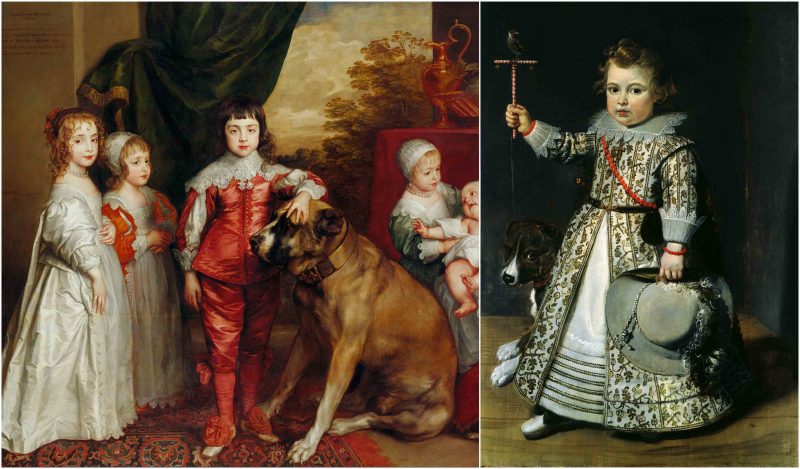Have you noticed how in medieval paintings fair blond girls in flamboyant dresses are prevalent, whereas there is a lack of boys in pants? – That’s because many of those cutesy girls in dresses are actually boys. No, the reason is not medieval cross-dressing, but a process of potty training. From the mid-16th century until the late 19th or early 20th century, young boys in the Western world wore gowns or dresses until an age that varied between two and eight. The main reason for keeping boys in dresses was toilet training – or the lack thereof. Dresses were also easier to make with room for future growth, in an age when clothes were much more expensive than now for all classes.
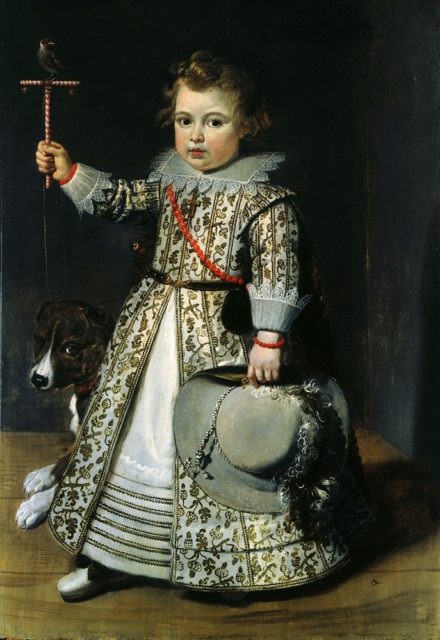
When the boys had reached the age when they could easily undo the rather complicated fastenings of many early-modern breeches and trousers, there was a special occasion and celebration called “Breeching,” when a small boy was first dressed in breeches or trousers. The age at which a child was capable of proper reasoning was considered to be about seven, and breeching corresponded roughly with that age for much of the period.
In the 19th century, photographs were often taken of the boy in his new trousers, typically with his father. He might also collect small gifts of money by going around the neighborhood showing off his new clothes. Friends of the mother as much as the boy might gather to see his first appearance. A letter of 1679 from Lady Anne North to her widowed and absent son gives a lengthy account of the breeching of her grandson:
“…Never had any bride that was to be dressed upon her wedding-night more hands about her, some the legs and some the armes, the taylor buttn’ing and other putting on the sword, and so many lookers on that had I not a ffinger [sic] amongst them I could not have seen him. When he was quit drest [sic] he acted his part as well as any of them…. since you could not have the first sight I resolved you should have a full relation…”
The dresses he wore before she calls “coats.”
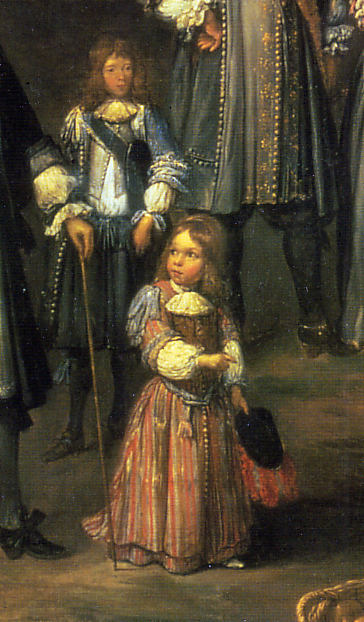
The first progression, for both boys and girls, was when they were short coated, or taken out of the long dresses that came well below the feet that were worn by babies — and which have survived as the modern Christening robe. It was not possible to walk in these, which no doubt dictated the timing of the change. Toddlers’ gowns often featured leading strings, which were narrow straps of fabric or ribbon attached at the shoulder and held by an adult while the child was learning to walk.
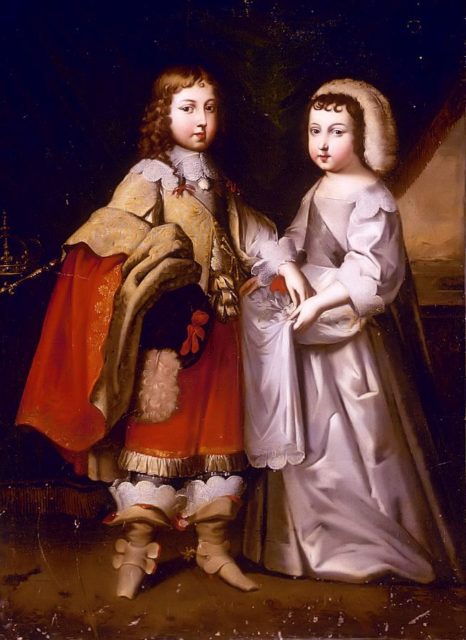
After this stage in the Early-Modern period, it is usually not too difficult to distinguish between small boys and girls in commissioned portraits of the wealthy, even where the precise identities are no longer known. The smaller figures of small children in genre painting have less detail, and painters often did not trouble to include distinguishing props as they did in portraits. Working-class children presumably were more likely than the rich to wear handed down clothes that were used by both sexes. In portraits, the colors of clothes often keep the rough gender distinctions we see in adults — girls wear white or pale colors, and boys darker ones, including red. This may not entirely reflect reality, but the differences in hairstyles, and in the style of clothing at the chest, throat and neck, waist, and often the cuffs, presumably do.
In the 19th century, perhaps as childhood became sentimentalized, it becomes harder to tell the clothing apart between the sexes; the hair remains the best guide, but some mothers were evidently unable to resist keeping this long too. By this time the age of breeching was falling closer to two or three, where it would remain. Boys in most periods had shorter hair, often cut in a straight fringe, while girl’s hair was longer, and in earlier years sometimes worn “up” in adult styles, at least for special occasions like portraits. In the 19th century, wearing hair up itself became a significant rite of passage for girls at puberty, as part of their “coming out” into society. Younger girls’ hair was always long, or plaited. Sometimes a quiff or large curl emerges from under a boy’s cap. Boys are most likely to have side partings, and girls center partings.
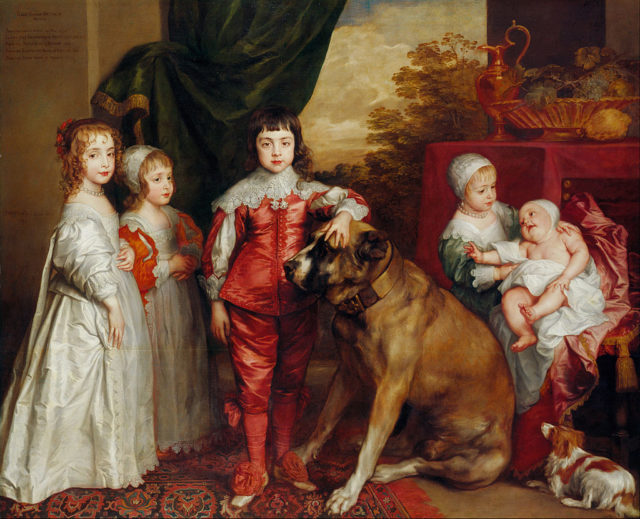
The children of King Charles I of England in 1637 by Van Dyck. From left: Mary, James — unbreeched at four, Charles, Elizabeth and Anne. In portraits even very young girls may wear necklaces, often of pearls. In the Van Dyck portrait of the children of Charles I, only the absence of a necklace and the color of his dress distinguish the unbreeched James (aged four) from his next youngest sister Elizabeth, whilst their elder brother and sister, at seven and six, have moved on to adult styles. In cases of possible doubt, painters tend to give boys masculine toys to hold like drums, whips for toy horses, or bows.
Girls’ bodices usually reflected adult styles, in their best clothes at least, and low bodices and necklaces are common. Boys often, though not always, had dresses that were closed up to the neckline and often buttoned at the front — rare for girls. They frequently wear belts, and in periods when female dresses had a V at the waist, this is often seen on little girls, but not on boys. Linen and lace at the neck and cuffs tend to follow adult styles for each gender, although again the clothes worn in portraits no doubt do not reflect everyday wear, and may not reflect even best clothes accurately.
Unbreeched boys of the nobility are sometimes seen wearing swords or daggers on a belt. A speech by King Leontes from Shakespeare’s The Winter’s Tale implies that, as common sense would suggest, these could not be drawn, and were purely for show:
-
- Looking on the lines
- Of my boy’s face, methought I did recoil
- Twenty-three years, and saw myself unbreech’d
- In my green velvet coat, my dagger muzzled,
- Lest it should bite its master, and so prove
- (As ornament oft does) too dangerous.
— he also calls his dress a “coat”; “cote” was a French and English term, dating back to the Middle Ages, for earlier adult male gowns and seems to have been kept in use for boys’ clothes to preserve some gender distinction.
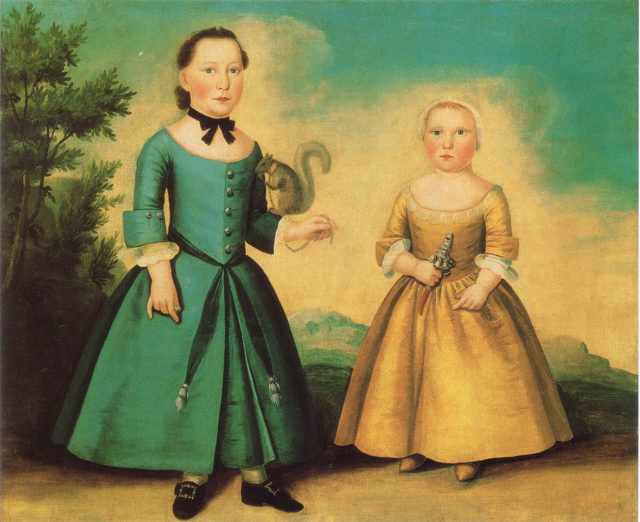
Usually, jewelry is not worn by boys, but when worn it is likely to be dark in color, such as coral beads. Coral was considered by medical authorities the best material to use for teething aids, and a combined rattle and whistle (in silver) and teething stick (in coral) can be seen in many portraits.
In the late 18th century, new philosophies of child-rearing led to clothes that were thought especially suitable for children. Toddlers wore washable dresses called frocks of linen or cotton. British andAmerican boys after perhaps three began to wear rather short pantaloons and short jackets, and for very young boys the skeleton suit was introduced. These gave the first real alternative to dresses and became fashionable across Europe.
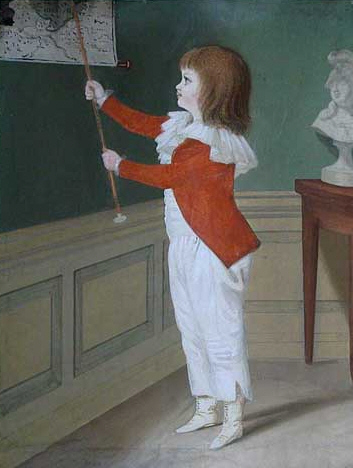
The skeleton suit consisted of trousers and tight-fitting jacket, buttoned together at the waist or higher up; they were not unlike the romper suit introduced in the early 20th century. But dresses for boys did not disappear, and again became standard from the 1820s, when they were worn at about knee-length, sometimes with visible pantaloons called pantalettes as underwear, a style also worn by little girls.
As the next stage, from the mid-19th century boys usually progressed into shorts at breeching — again these are more accommodating to growth, and cheaper. The knickerbocker suit was also attractive. In England and some other countries, many school uniforms still mandate shorts for boys until about nine or ten. The jackets of boys after breeching lacked adult tails, and this may have influenced the adult tail-less styles which developed, initially for casual wear of various sorts, like the smoking-jacket and sports jacket. After the First World War, the wearing of boy’s dresses seems to have died out, except for babies.
